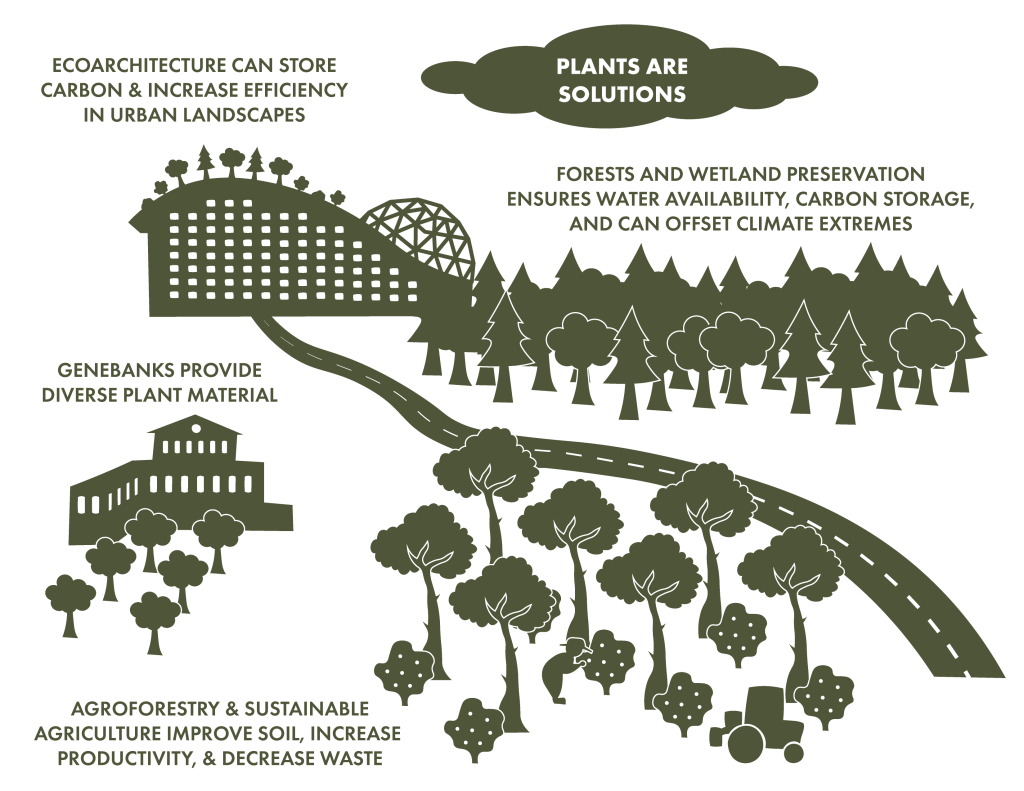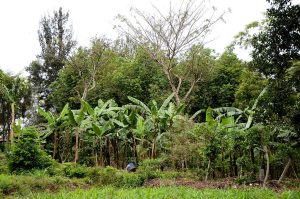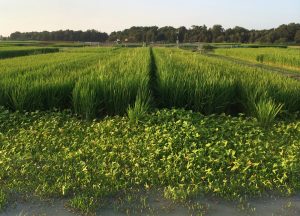Importance of plants for mitigating and adapting to the effects of climate change
Gayle M. Volk, USDA-ARS National Laboratory for Genetic Resources Preservation, 1111 S. Mason St., Fort Collins, CO USA 80521 (Gayle.Volk@usda.gov)
Patrick F. Byrne, Department of Soil and Crop Sciences, Colorado State University, Fort Collins, Colorado USA 80523 (Patrick.Byrne@colostate.edu)
Tara L. Moreau, University of British Columbia Botanical Garden, 804 SW Marine Drive, Vancouver, BC Canada V6T 1Z4 (Tara.Moreau@ubc.ca)
Learning Objectives
Understand and describe how plants are key to mitigating climate change and helping us adapt to its effects.
outline
- Introduction
- Approaches for plant-based mitigation of and adaptation to the effects of climate change
- Plants are solutions: Principles of resilient food systems
- Conclusions
- References
- Acknowledgments
1. introduction
Plants play a critical role in the global carbon cycle and are key to climate change mitigation and adaptation solutions. Through photosynthesis, plants remove carbon dioxide (CO2) from the atmosphere and store it as plant biomass. Carbon accumulates in above- or below-ground plant tissues (branches, stems, roots, etc.) and is added to soils through decomposition. The length of time plants store or sequester carbon varies and greatly impacts the global carbon cycle.
1.1. Plant-based climate change mitigation
Climate change mitigation involves reducing, preventing, or removing greenhouse gases from the atmosphere. Plant-based approaches that address atmospheric CO2 include:
- Protecting high-carbon ecosystems that hold or increase carbon storage (particularly in soils and in plant-rich landscapes such as forests)
- Practicing agroforestry (incorporating trees and shrubs in crops and pastureland) to improve soil health, ecological diversity, and increase land productivity
- Using sustainable agricultural approaches that decrease dependency on high-input field production
- Breeding crops for improved carbon sequestration (e.g., through increased deep root biomass or for biological nitrification inhibition)
- Developing urban landscapes that minimize water use and sequester carbon
1.2. Plant-based adaptation to climate change
Adapting to climate change and its subsequent effects involves making adjustments in response to predicted changes, as well as novel conditions or knowledge. Plants play critical roles in adapting to climate change and plant-based adaptation strategies include:
- Maintaining diverse forest habitats that offset temperature and moisture extremes
- Selecting biodiverse cropping systems to retain productivity as a result of a wide range of environmental responses
- Identifying, developing, and growing a diversity of food plants and agricultural crops
- Selecting and producing crops/cultivars that reduce the need for inputs and reduce waste at all stages: on the farm, during processing and storage, and by the consumer

2. Approaches for Plant-Based Mitigation of and Adaptation to the effects of climate change
The role of plants in mitigating and adapting to climate change is key. An introduction to some important approaches is highlighted in a few examples below.
2.1. Agroecology, agroforestry, and Forest ecosystems
Adaptations to climate change that make use of agroecological strategies include crop diversification/biodiversity, maintaining local genetic diversity, soil organic matter management, and water conservation. This could include agroforestry systems that incorporate perennial plants that both capture carbon and provide shade (Altieri et al., 2015). Agroecological methods that incorporate landscape biodiversity can increase resilience to climate-related shocks and disturbances that affect productivity (Queiroz et al., 2021). Biodiversity enhances resilience because crops and cultivars differ in their environmental responses, thus occupying different niches in changing conditions (Vandermeer et al., 1998).

Agroforestry is a sustainable land-use system that incorporates trees and shrubs into cropland and pastureland. Agroforestry practices conserve biodiversity, sequester carbon, block wind, and provide food sources (Abbas et al., 2017; Mbow et al., 2014). Forest ecosystems sequester carbon within woody plants and in healthy organic-matter rich soils (Udawatta et al., 2022). These forest ecosystems absorb 15 to 20% of annual human carbon emissions, and thus play an important role in climate change mitigation (Le Quéré et al., 2018; Case et al., 2021). Water is also retained in high quality soils, thereby promoting additional plant growth and reducing the occurrence of wildland fires. Forest ecosystems help buffer the environmental extremes that could be experienced in a changing climate. Shade and moisture-rich microclimates caused by evapotranspiration reduce extreme temperature fluctuations that might occur (De Frenne et al., 2021).
2.2. Agriculture
Agricultural production methods play a key role in climate change mitigation and adaptation. For mitigation, adoption of agricultural practices that apply specifically targeted fertilization regimes to single-crop cultivated systems can reduce inputs, decrease water waste, fossil fuels, and unharvested products, which in turn reduce emissions and increase net productivity (Hartin et al., 2014; McPherson et al., 2005; Turner-Skoff and Cavender, 2019). Plant breeding is developing new crops with deep root systems that can sequester carbon (van der Pol et al., 2022). In addition, the choice of plant-based protein sources (such as pulse crops) instead of animal-based proteins reduces agricultural greenhouse gas emissions by reducing methane released in animal production.

Incorporating climate adaptation action in agriculture aligns with sustainable agriculture practices and can enhance these efforts by considering climate vulnerabilities and potential future threats. For example, organic agriculture practices support soil fertility and pest management and can also enhance the resilience of farms to climate changes. The United Nations Climate-Smart Agriculture program is an example of one approach to develop actions to ensure food security under climate change (Loboguerrero et al., 2019). It aims to develop synergies between climate mitigation, adaptation, and food security, particularly for small farms in developing countries, but it also has implications for large-scale agriculture. The goals of the United Nations Climate-Smart Agriculture program are to:
- Sustainably and equitably increase agricultural productivity and incomes
- Help food systems and family livelihoods to be more resilient
- Minimize agricultural greenhouse gas emissions
Video 1. Video describing the ‘Climate-Smart Agriculture’ program.
2.3. Urban Forests and gardens
Gardens and urban forests are important for both mitigating and adapting to climate change. In urban areas, sustainable gardening and landscaping helps minimize water use and sequesters atmospheric carbon both above and below ground (Hartin et al., 2014; McPherson et al., 2005; Turner-Skoff and Cavender, 2019). The Grow Green Guide is a sustainable gardening resource designed for people living in the Metro Vancouver area of Canada. This resource provides over 100 garden designs and information on over 300 plant selections based on criteria including native range, pollinator-friendliness, ability to provide food, water-wise, etc.
3. plants are solutions: principles of resilient food systems
A food system is the network of activities connecting people to their food. According to Schipanski et al. (2016), resilient food systems occur when people produce and access nutritious and culturally acceptable food over time and space in the face of disturbance and change. There are increasing efforts to identify and understand important qualities of resilient food systems. Worstell and Green (2017) use case studies to identify eight qualities common to ecologically resilient food systems and explore how these qualities could be quantified and used.
Qualities common to ecologically resilient food systems:
- Complementary diversity
- Conservative innovation and flexibility (open to new ideas)
- Ecological integration (working with nature)
- Modular connectivity (among farmers, marketers, and suppliers)
- Locally self-organized
- Periodic transformation: Reorganizing, reforming, embracing disturbance
- Physical infrastructure and accumulating reserves
- Responsive redundancy or back-ups
Resilient food systems depend on access to diverse plant genetic resources that are made available through conservation efforts. Agricultural production using biodiverse strategies improves ecosystem function because the diversity of species acts as a buffer against failures caused by environmental fluctuations. If one species fails, others can compensate, thus improving the overall health and productivity of the ecosystem (Altieri et al., 2015).
Schipanski et al. (2016) list additional strategies to improve food system resilience, including:
- Educational gender-equity and women’s empowerment, which influences family dietary choices, human nutrition, and can minimize food waste
- Utilizing ecological, multi-crop systems rather than single-crop production based on intensive external inputs
- Improving regional food distribution networks
- Linking human nutrition and food production policies
4. Conclusions
Plants play a powerful role in mitigating and adapting to climate change. Forest ecosystems store vast quantities of carbon and affect temperature and moisture regimes. Sustainable agricultural methods have the potential of significantly reducing greenhouse gas emissions. Incorporating sustainable gardening and forestry into urban landscapes has the power to reduce water use and activate more regions of the planet for carbon sequestration. Conserving and using biodiversity will be especially important for building food system resilience, if changing climates affect the stability of crop yields. These efforts depend on access to diverse forms of plant genetic resources.
5. references
Abbas F, Hammad HM, Fahad S, et al. 2017. Agroforestry: a sustainable environmental practice for carbon sequestration under the climate change scenarios—a review. Environmental Science and Pollution Research 24:11177-11191. DOI: 10.1007/s11356-017-8687-0
Altieri M, Nicholls CI, Henao A, Lana MA. 2015. Agroecology and the design of climate change-resilient farming systems. Agronomy for Sustainable Development 35:869-890. DOI: 10.1007/s13593-015-0285-2
Case MJ, Johnson BG, Bartowitz KJ, Hudiburg TW. 2021. Forests of the future: Climate change impacts and implications for carbon storage in the Pacific Northwest, USA. Forest Ecology and Management 482:118886. DOI: 10.1016/j.foreco.2020.118886
De Frenne P, Lenoir J, Luoto M, Scheffers BR, Zellweger F, Aalto J, Ashcroft MB, et al. 2021. Forest microclimates and climate change: Importance, drivers and future research agenda. Global Change Biology 27:2279-2297. DOI: 10.1111/gcb.15569
Hanafiah NM, Mispan MS, Lim PE, Baisakh N, Chen A. 2020. The 21st century agriculture: When rice research draws attention to climate variability and how weedy rice and underutilized grains come in handy. Plants 9:365. DOI: 10.3390/plants9030365
Hartin J, Geisel P, Harivandi A, Elkins R. 2014. Sustainable landscaping in California. University of California. Division of Agriculture and Natural Resources Publication 8504. Available from: escholarship.org/uc/item/2xg41968
Le Quéré C, Andrew RM, Friedlingstein P, Sitch S, Hauck J, Pongratz J, Pickers PA, Korsbakken JI, et al. 2018. Global Carbon Budget 2018, Earth System Science Data 10:2141-2194. DOI: 10.5194/essd-10-2141-2018
Loboguerrero AM, Campbell BM, Cooper PJM, Hansen JW, Rosenstock T, Wollenberg E. 2019. Food and earth systems: Priorities for climate change adaptation and mitigation for agriculture and food systems. Sustainability 11:1372. DOI: 10.3390/su11051372
Mbow C, Van Noordwijk M, Luedeling E, Neufeldt H, Minang PA, Kowero G. 2014. Agroforestry solutions to address food security and climate change challenges in Africa. Current Opinion in Environmental Sustainability 6:61-67. DOI: 10.1016/j.cosust.2013.10.014
McPherson EG, Simpson JR, Peper PJ, Maco SE, Xiao Q. 2005. Municipal forest benefits and costs in five US cities. Journal of Forestry 103:411-416. Available from: fs.usda.gov/research/treesearch/45956
Queiroz C, Norström AV, Downing A, et al. 2021. Investment in resilient food systems in the most vulnerable and fragile regions is critical. Nature Food 2:546-551. DOI: 10.1038/s43016-021-00345-2
Schipanski ME, Macdonald GK, Rosenzweig M, Chappell MJ, Bennett EM, Kerr RB, Blesh J, et al. 2016. Realizing resilient food systems. Bioscience 66:600-610. DOI: 10.1093/biosci/biw052
Turner-Skoff JB, Cavender N. 2019. The benefits of trees for livable and sustainable communities. Plants People Planet 1:323-335. DOI: 10.1002/ppp3.39
Udawatta RP, Walter D, Jose S. 2022. Carbon sequestration by forests and agroforests: a reality check for the United States. Carbon Footprints 1:8. DOI: 10.20517/cf.2022.06
van der Pol LK, Nester B, Schlautman B, Crews TE, Cotrufo MF. 2022. Perennial grain Kernza® fields have higher particulate organic carbon at depth than annual grain fields. Canadian Journal of Soil Science 102:1005-1009. DOI: 10.1139/CJSS-2022-0026
Vandermeer J, van Noordwijk M, Anderson J, Ong C, Perfecto I. 1998. Global change and multi-species agroecosystems: Concepts and issues. Agriculture, Ecosystems & Environment 67:1-22. DOI: 10.1016/S0167-8809(97)00150-3
Worstell J, Green J. 2017. Eight qualities of resilient food systems: Toward a sustainability/resilience index. Journal of Agriculture, Food Systems, and Community Development 7:23-41. DOI: 10.5304/jafscd.2017.073.001
6. acknowledgments
Citation: Volk GM, Byrne PF, Moreau TL. 2023. Importance of plants for mitigating and adapting to the effects of climate change. In: Volk GM, Moreau TL, Byrne PF. Conserving and Using Climate-Ready Plant Collections. Fort Collins, Colorado: Colorado State University. Date accessed. Available from: https://colostate.pressbooks.pub/climatereadyplantcollections/chapter/importance-of-plants/
This eBook chapter was developed through a collaboration among USDA-Agricultural Research Service, Colorado State University, and the University of British Columbia Botanic Garden, with additional funding from the USDA-NIFA-Higher Education Challenge Grant (2020-70003-303930).
Editor: Katheryn Chen
in a climate change context, actions that reduce or prevent greenhouse gas emissions or that lower the amount of greenhouse gases in the atmosphere
in a climate change context, taking action to prepare for and adjust to both the current and projected impacts of climate change
the capture and storage of atmospheric carbon dioxide
a crop variety produced by scientific breeding or farmer selection methods
relating to ecological processes applied to agricultural production
the network of activities connecting people to their food
the organs and tissues (seeds, fruits, cuttings, pollen, tissue cultures, etc.) by which plants can be propagated (synonymous with plant germplasm)

